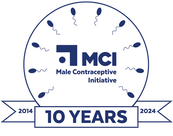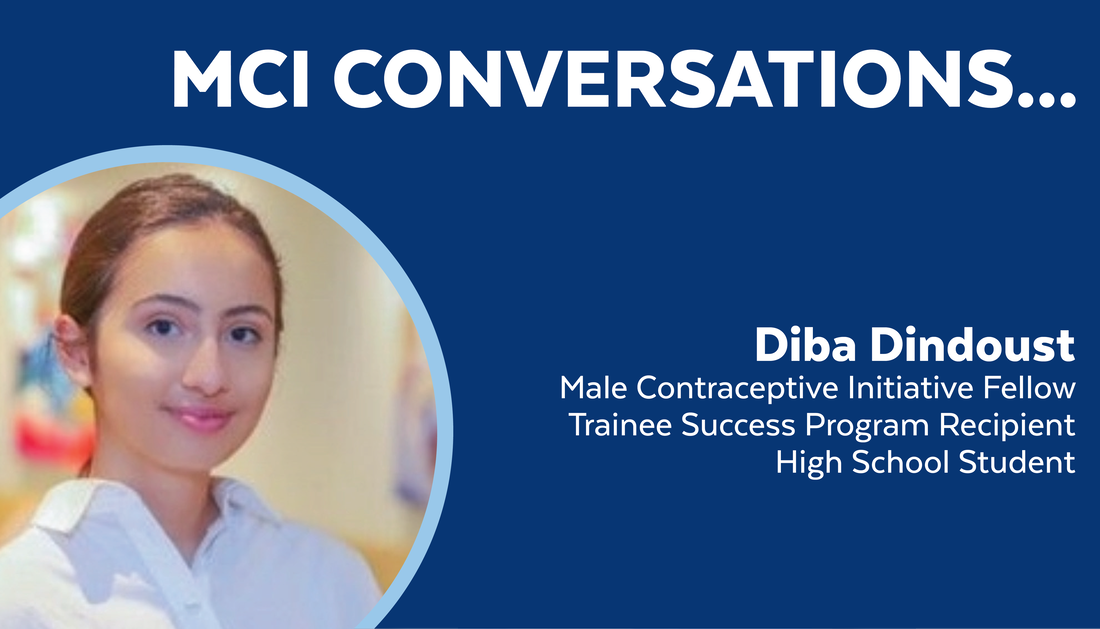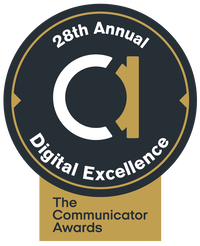|
Support for young researchers is a key pillar of MCI’s work in furthering the progress of male contraception. We find it so important that we have a variety of ways to get behind today’s brightest, including a fellowship program, internships, and our Trainee Success program. The Trainee Success Program is one of our most versatile ways to help young researchers as it comes to meet students where they are. If they are in need of travel support, professional development, or other help, our Success Program can find a way to develop these young scientists in such a way that the future of male contraception is sustained for years to come. Recent Trainee Success Recipient, Diba Dindoust, visited the lab of MCI grantees, Dr. Lonny Levin and Dr. Jochen Buck, and shares her thoughts about the experience in this blog post. My name is Diba, and since the age of 17, I’ve been passionate about creating non-hormonal male contraceptive pills that can soon reach the market. So, over the past year and a half, I’ve been up to some cool projects: I first came up with an ideato use computational screenings to repurpose existing drugs, which would reduce the time it would take to develop a non-hormonal male contraceptive pill. I conducted this research at the University of Minnesota and learned tons about medicinal chemistry, designing drug molecules and used tools like molecular docking, HPLC, mass spectrometer, etc. This experience was my first in-person exposure to the drug discovery world. Upon leaving Minneapolis, I wanted to learn more about how non-hormonal male contraceptive targets and their inhibitors are studied in animal models. And thus began an unforgettable trip to Weill Cornell Medicine in NYC. Visiting the lab developing an on-demand non-hormonal male contraceptive pill… The LevinBuck lab at Weil Cornell Medicine, led by Dr. Lonny Levin and Dr. Jochen Buck, has developed an experimental drug that can immobilize a sperm for up to two and a half hours, preventing pregnancies in a preclinical mouse model. The team has been working on a cellular signaling protein called soluble adenylyl cyclase (sAC) for decades and discovered that mice genetically engineered to lack sAC are infertile. sAC is a protein that converts ATP into cAMP, the initial signaling event that results in sperm motility and capacitation. Dr. Melanie Balbach, a postdoctoral associate on the team, while working on an sAC treatment for an eye condition, also found that mice treated with sAC inhibitors cannot swim forward. Upon reports by another team that men lacking the sAC gene are infertile but otherwise healthy, the LevBuck team set out to develop a male contraceptive that would disrupt sperm motility by inhibiting sAC. And unlike other non-hormonal male contraceptives, this drug is also on-demand. I set out to experience the work of the scientists first-hand. First, I want to give some important shoutouts: I’m very grateful to Dr. Levin, Dr. Buck and Dr. Balbach for hosting me in their lab for a week to assist with research on sAC and Catsper inhibitors with various animal models. And I appreciate the Male Contraceptive Initiative for supporting me in this experience and for all they do to propel male contraceptive research forward. Now onto my goals going into this experience: Contributing to male contraceptive research:
1. Carrying out preliminary experiments on Catsper inhibitors in mouse, rabbit and human sperm The main sperm-specific Ca2+ channel, Catsper, is a famous contraceptive target in the male contraceptive field because it plays an important role in mammalian fertilization and is testes- specific. A potent Catsper inhibitor, HC-056456, has been tested in the past by Curci et al. at different concentrations (1–20 µm), where they found in vitro that while the viability of both capacitated and non-capacitated sperm exposed to HC was not affected, they showed significantly less Ca2+ entry into the cell, progressive motility, protein tyrosine phosphorylation, induced acrosome reaction, hyperactivation and ability to fertilize cumulus-oocyte complexes and zona-free eggs. As well in vivo, the percentage of oviductal fertilized eggs was significantly or completely reduced when HC-treated sperm was inseminated into the mouse uterus. In other words, this study presented Catsper as a great male contraceptive target because a Catsper inhibitor reduced the function of mature sperm. However, the HC inhibitor is still a long way off from becoming a male contraceptive because for it to have a significant impact on a human male, with the current potency, a very large quantity of it would have to be taken, which could certainly not be conveniently packaged in a coin-sized pill. As well, the HC inhibitor can be even more potent and it would have to have optimal metabolism in humans. But most fundamentally, scientists have yet to understand the Catsper protein in mammals other than mice properly. We must first fully understand this protein in humans and other mammals before improving the HC inhibitor. So what did I do with this research inquiry in one intense and action-packed week? Dr. Balbach and I conducted an experiment similar to Curci et al. and another experiment to evaluate other functions of Catsper in sperm samples from three different mammals: mice, rabbits and humans. To evaluate the motility of HC-exposed sperm at different concentrations, we used a CASA analysis like Curci et al., comparing our results to the motility of non-inhibited sperm and sAC inhibitor-exposed sperm. With the CASA tool, I saw a film of sperm magnified under a microscope. I observed how the sperm became so still when exposed to HC. It was so fascinating to put the observations of another group of researchers to the test and see if we could get the same results in three independent repetitions. Since we knew that the main function of Catsper is allowing Ca2+ ions to enter and leave sperms, we also tested to see if Catsper affected cAMP accumulation like sAC. We used an assay called ELISA which measures how much cAMP was produced. I found it interesting to plot the data we collected and compare the cAMP concentration with increasing concentrations of HC. With both the CASA analysis and ELISA assay, I noticed the differences in results from the three different species, which highlighted why it is so important to understand the function of therapeutic protein targets in multiple mammals and test out compounds in at least two animal models before a drug can be developed and put on the market for human use. Even though we only did a small number of experiments in our limited time, I enjoyed generating preliminary data that excited me to think further about this research inquiry. 2. Experiential learning > just textbook learning (but in moderation) During my last day in NYC, while waiting for a train back to my hotel from Central Park, I reminisced every memory I had made in the past week: doing a Western Blot for the first time, setting up an Elisa assay, preparing semen and sperm samples from mice + rabbits + humans, being asked to interpret the results from a CASA motility sample, discussing with lab members how they're designing their studies. There was an overwhelming amount of new data that my brain had to process. I had never in my life been exposed to so much information in a short period of time. Yes, I had studied how an assay like Western Blot works from a textbook, but the amount of information I was exposed to was x10 when I did it in a real-world context. Having done the technique catalyzed my uptake of the skill. I don’t think anything I’m saying here is novel — experiential learning exists for medical students, graduate students, and some undergraduates. Although these are traditional paths of education that not everyone wants to follow, we can learn from them that to learn any skill; it is better to do it than to read about it in a textbook. Anyone following a non-traditional education path can apply this principle by seeking experiential learning opportunities through shadowing, internship and volunteering experiences. But as I stepped into the train to return to my hotel, I had many unanswered fundamental questions. For example, I had worked with a cAMP Elisa assay, but other than the function of cAMP for sperm motility, I still did not know the role of this molecule in the body. This uncertainty did not hold me back from doing this assay. Still, at the same time, I realized that without having a more comprehensive understanding of biochemistry, I could not apply my knowledge of this assay to find new use cases or do any work beyond sperm motility analysis. This is why I pulled out the good ol’ textbooks when I returned to Toronto. I spent 2 days reading a textbook on andrology cover-to-cover and gained a wider understanding of andrology- related biochemical pathways in the human body. While doing so, I was also able to brainstorm new ideas for projects that I could work on, and this broke me out of my creative block. I realized that experiential learning is not sufficient on its own, even though today, it is idolized as the standard of education. When I now think about the process of learning, I see it as a cycle: textbooks → experiences → textbooks → experience To be proficient at a skill and to manage coming up with certain new ideas, repeating the cycle 2x is sufficient. Of course, to be a master at a skill and a powerhouse ideator, the cycle is endless and will span your life. So, while experiential learning has more value than textbook learning in any discipline, even the biomedical sciences, we still need to incorporate textbooks into the learning process. Although the traditional form of education may not have many fans in modern times, it doesn’t mean its methods are not valuable. But they need to be complemented by real-world experiences because experiential learning gives you the skills to figure out roadblocks, make meaningful connections with wonderful people by being on the field, and make memories that give existential value to learning. By taking the time after my trip to the LevBuck lab to reflect from a meta angle on how I learned, I’m beginning to fine-tune my strategies to learn any skill or concept. Life is just a period of learning — skills, concepts, emotions and feelings — so optimizing and personalizing the learning process for oneself is important. 3. Academic research Beyond exploring an interesting research inquiry and learning tons of biochemistry and assay techniques, I spent a week surrounded by great people passionate about their research. I enjoyed listening to every lab member describe their projects and their goals. It made me realize how awesome it is that academia is like a playground that gives scientists and researchers to explore questions that motivate them. The passion of everyone I met also made me excited to think about my own aspirations. Do I pursue academic research or not? I’ve always liked tinkering with ideas and testing them out. I’ll certainly be bringing my ideas and continuing to do academic research while in my undergraduate years. And while I enjoyed academic research, I know how difficult it is to access the required resources, which is why I hope to contribute towards making access to research resources easier and more available to everyone, whether they live close to an academic institution or not. Please visit this page to learn more about our Trainee Success Program:
0 Comments
Your comment will be posted after it is approved.
Leave a Reply. |
Categories
All
Archives
June 2024
|
|
|
Donate to Male Contraceptive InitiativeYour generous donation makes a difference!
|
© Male Contraceptive Initiative. All rights reserved.


 RSS Feed
RSS Feed
